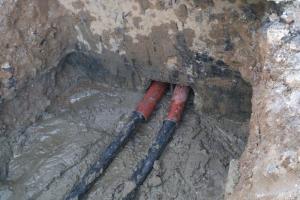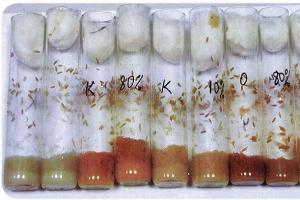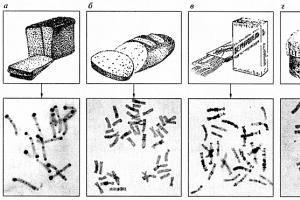In this article, I will describe several examples of when water flows poorly and why there is no pressure in the riser; accordingly, there will be no pressure in the apartments either. First, you need to accurately determine whether the fluid flows equally poorly in all apartments or in several.
I described the options for why it happens when the problem is in the internal wiring, and in this article I will describe the reasons in the basement.
Water flows poorly through the riser
1. It has a coarse filter installed (very rare), which is clogged with rust, scale and dampens the pressure.
2. The insert is overgrown, mainly in welding areas.
3. The valve broke, when closing the riser the “nickel” fell off the rod, when opening the valve it looked like it opened, but the water is flowing weak.
4. Pipes become overgrown.
What to do if there is no pressure
1. The first reason is the easiest to eliminate - it is necessary. Turn off the tap on the riser, unscrew the filter, clean the mesh.
2. If the tap is overgrown, then you need to turn off the water to the house; if there is a shutoff to the entrance, then turn it off. Next, you should unpack the squeegee, unscrew the tap, and make a tap.
3. Very often on a cast iron faucet, after it is closed and opened, the “penny” with the gasket remains in the seat, and the stem is unscrewed, and there is actually no pressure, since it turns out to be closed. You need to unscrew the valve axle, having first turned off the water, and install a new one.
4. The only way to fight the fourth reason is...
These are the main and most frequent breakdowns that I have encountered.
Housewives often face a problem when water does not flow well from the tap. There are many options why this happens. As well as eliminating these very problems. However, in all cases, the first thing you need to decide is how you will fix the problem - yourself or with the help of a plumber.
If you are completely confident in your abilities, or you have your own personal “jack of all trades,” then definitely get to work quickly. You should look for the cause step by step.
First of all, you need to check the pipes. If they are metal and very old, they may simply be rusty and clogged. Then they are purged with a special pump, or some other device suitable for this; this operation should be entrusted to specialists.
The next thing to check is the faucet itself. It has components that could very well fail. Various kinds meshes, filters, faucets and the so-called gander itself. All small parts must be carefully removed and washed. If the mesh is small, you can use a brush. The problem may also be in coarse water filters if you have OSMOSIS. In this case, all filters must be removed and washed. Check the entire water supply system to the tap.
The next thing that can let you down is the banal water pressure in the water supply. In this case, you need to contact the housing and communal services, they will have to fix the problem. Don't forget that it is for fast response and troubleshooting that you pay monthly.
Remember, if water does not flow in one tap, then this is a local problem. If it’s throughout the entire apartment, then you can’t do without specialists. Only they will tell you exactly what the problem is.
This applies to the use of water from the public water supply system. If this a private house who has his own well and uses automation to supply water to the system, then the principle here is as follows.
Namely: it is necessary to check filters from the well, filters throughout the house, taps that supply or shut off water.
The reason may be the pump; it may not be powerful enough. Automation can also fail. And of course, it doesn’t hurt to check the mixers either.
In any case, there are problems that you can eliminate on our own, but there are also some that you cannot cope with. The main thing here is not to overdo it. And if necessary, it is better to seek help.
So, let’s summarize why water can flow poorly from a tap, in a small trickle:
- poor condition of pipes;
- mixer malfunction;
- no pressure;
- problems with the system.
Add site to bookmarks
- Kinds
- Choice
- Installation
- Finishing
- Repair
- Installation
- Device
- Cleaning
Causes of water leaking from the faucet and their elimination
- Preparation for repair
- If water flows from a single lever faucet
- If water flows from a mixer with two taps: replacing the faucet
- Leaking due to a faulty shower-bath switch
Every day, faucets repeatedly perform their functions; the coziness and comfort of a bathroom or kitchen depends on their reliability and quality. Sometimes even the most expensive plumbing equipment fails. Faucets can leak for a variety of reasons, but don't go straight to the hardware store to buy a new set.
Mixer assembly diagram and its main components.
Practice shows that in order to eliminate a leak that suddenly appears, it is enough to have a standard set of plumbing tools.
Preparation for repair
If water is dripping or leaking from the faucet, you will need:
- spare parts from the repair kit for the mixer;
- Phillips and regular screwdrivers;
- pliers or pliers;
- set of hexagons;
- drill with a set of drills;
- adjustable wrench;
- tow (twine, linen thread, burlap fibers);
- fum tape;
- new gaskets;
- shallow container;
- dry rags or unnecessary towels;
- sealant.
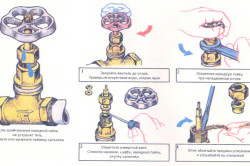
Before carrying out work, be sure to turn off the water supply and close the corresponding valves installed on the outlets of the water supply risers. The water from the tap must be drained. Place a small container under the dripping water so that the water from the tap and connection hoses flows into it, also prepare rags or towels. The causes of leakage may be wear of the gasket and abrasion of the rod thread when the gasket is not tightly pressed to the saddle, as well as wear of the oil seal and stuffing box, or a manufacturing defect. The faucet most often leaks at the hose connection, from the water supply hole itself and from the base of the tap. Mixers come in single-lever and double-tap types. First, you should consider the most common causes and the possibilities for correcting them in situations where water flows from a single-lever mixer.
Return to contents
If water flows from a single lever faucet
First, you need to carefully inspect the tap; you can visually determine the causes of the leak. Most often, a chip or crack is observed on the body; in this case, you can try to cover them with sealant, if the size of the damage allows. This measure is temporary, especially if the chip is significant, then all that remains is to replace the part with a new one. If the housing is intact, but there is a leak, it is necessary to check the condition of the gasket. Replacing the gasket involves complete dismantling mixer, this can be done by unscrewing the nuts on the body. If the mixer has a decorative casing (according to the aesthetic design, the casing covers the fasteners), then you just need to move it to the side. When access is open, you need to unscrew the nuts and remove the mixer. When the mixer is dismantled, the condition of the gasket is immediately visible, which can be easily replaced with a new one if desired. After replacing the gasket, do not over-tighten the nuts, this will lead to pinching and rapid wear.
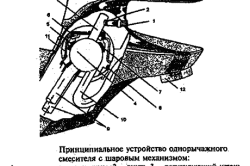
If water flows from the faucet built into the sink, and the sink itself is attached to the wall, then the situation is more serious. The most common cause of leakage in these faucets is wear of the ceramic built-in cartridge. In this case, use a screwdriver, knife or other sharp object to pry top cover lever mechanism. The cover can be removed with a little effort and thus provides access to the mixer locking screw. After the lever handle is removed, it is the turn of the decorative and then the union nut. This opens access to the brass or ceramic cartridge - the main cause of leakage. The cartridge is easily removed and replaced with a new one. The main thing in this matter is the compatibility of the cartridge with the model and brand of the mixer. The new cartridge is installed in the socket, the holes and grooves of the cartridge must strictly coincide with the grooves in the mixer body, after installation it must be secured with a union nut. After all the actions performed, the decorative nut is tightened and the lever handle returns to its place.
Return to contents
If water flows from a mixer with two taps: replacing the faucet
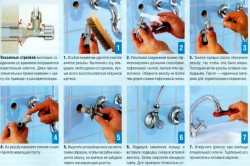
Faucets equipped with two taps (for cold and hot water) are easier to repair than lever ones. If the housing itself is not damaged, then the reason most likely lies in the wear of the oil seal, which is located in the mixer valve. The most simple action In this situation, tighten the nut all the way. If the nut is tightened tightly, but the leak is not eliminated, then the worn oil seal will have to be replaced. To do this, the union nut is dismantled, it is unscrewed using the appropriate tools, after which the oil seal sleeve is removed and a seal is inserted into the resulting gap. Thin twine or linen thread, or fiber from burlap, work well as a sealant. The rod is very carefully and tightly wrapped with a sealant when laying.
When making turns, the seal must be pressed extremely tightly against the rod, making sure to leave a gap for subsequent placement of the sleeve. After winding the seal is completed, the sleeve is placed in its place, the union nut is tightened. After these steps, you need to turn on the water; if everything was done correctly, then the process will be absent, and for a long time.
If, when you turn on the shower, water also flows from the mixer tap, you will need to replace the faucet - the locking element located in the mixer handles. The work of faucets is aimed at preventing water from flowing while the tap is closed. Crane boxes come in ceramic and with rubber gaskets; the second option is less reliable, as it wears out quickly, which leads to repeated damage. To replace the crane box, you need. To do this, use a screwdriver to remove the decorative parts from the handles, unscrew the screws that attach the handles to the faucet body and remove the faucets using an adjustable wrench. Then the new parts must be carefully screwed into place of the old ones, the main thing is not to overtighten the threads. If water flows from the mixer, from under the base of the tap, then the reason is most likely that the eccentrics are worn out. The eccentric connections can be sealed using sealant and ordinary tow; this will be enough to eliminate this type of leakage.






